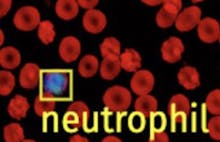Hematocrit
Definition, Test, Low vs High Levels and CausesWhat is hematocrit
Hematocrit (HCT) is the calculated volume percentage of red blood cells (erythrocytes) in your blood. Hematocrit is also called packed cell volume (PCV) or erythrocyte volume fraction.
Human blood contains red blood cells, white blood cells, and platelets suspended in a liquid called plasma. The word hematocrit means to separate blood. In a hematocrit test, the red blood cells are separated from the rest of your blood cells and plasma.
Hematocrit is important because red blood cells are essential to your survival. They contain a vital protein component called hemoglobin that binds to oxygen, which fuels all the cells in your body.
When red blood cells pass through your lungs, they bind to and transport oxygen to various cells in your body. On their way back to your lungs, they carry carbon dioxide to be exhaled. Hematocrit is a significant measurement as it can identify whether you have sufficient red blood cells for oxygen transportation and delivery.
If your doctor suspects that you have a blood disorder such as anemia or polycythemia (too many red blood cells), your doctor may order a hematocrit test to check your red blood cells.
How to measure hematocrit with a test?
The original method for hematocrit measurement is the macrohematocrit (Wintrobe hematocrit tube) method.
It uses a narrow glass tube and a centrifuge machine. The centrifuge separates the blood into three main layers: red blood cells, white blood cells, and platelets, in that order from the bottom up. At the very top, there’s a small layer of blood plasma. The macrohematocrit method carries the risk of measuring trapped plasma as part of the red blood cell layer, which erroneously elevates the hematocrit percentage.[1]
A newer method is the microhematocrit method, which uses a capillary tube instead of a narrow glass tube and requires a smaller quantity of blood and less time. The microhematocrit method traps less plasma because the diameter of the capillary tube is smaller than the Wintrobe hematocrit tube. So the percentage of hematocrit is more accurate in the microhematocrit method than in the macrohematocrit method.[1:1]
Both procedures require the technician to manually measure the length of the layers. The technician calculates hematocrit as the length of the packed red blood cell layer divided by the length of total cells and plasma. This ratio is then multiplied by 100 to give a certain percentage.
Today, these two methods have been largely succeeded by an automated hematology analyzer where the hematocrit test is obtained as part of a complete blood count (CBC) laboratory test. The hematocrit is calculated indirectly from the average volume and the number of red blood cells.[2] The automated analyzer is the fastest method. However, automated analyzers may not be available in areas where resources are low.
In the microhematocrit method, a technician only needs a small sample of blood from a finger-prick. In the other methods, the technician draws blood from the inner side of your arm or the back of your hand. Before drawing blood for the measurement, the technician first cleans the surface from where your blood would be drawn. Next, using a needle, the technician draws your blood. Afterward, the technician covers the surface with gauze and a bandage.
What is a normal hematocrit level?
Due to differences in age and gender, the normal hematocrit is a range. Hematocrit results are reported as a percentage. The average hematocrit measurement for human beings is 45%, which means that the red cell volume contains 45 mL per 100 mL of blood.[3]
According to the Cleveland clinic, the general normal ranges for hematocrit are[4]:
- Male: 41% to 50%
- Female: 36% to 44%
- Newborn: 45% to 61%
- Infant: 32% to 42%
What does it mean if your hematocrit is high?
If your hematocrit is high, it means that you have more red blood cells than is considered healthy.
High hematocrit may be caused by [4:1]:
- Heart disease
- Dehydration
- Scarring or thickening of the lungs
- Bone marrow disease
- Obstructive sleep apnea
- Smoking and chronic obstructive pulmonary disease (COPD)
- Carbon monoxide poisoning
- Testosterone use
A false high hematocrit may be reported if the patient has cryoproteins, significant leukocytosis, or giant platelets. Hematocrit measurement is critically high if it is greater than 67% (>67%).
What does it mean if your hematocrit is low?
If your hematocrit is low, it means that you have fewer red blood cells than is considered healthy.
Low hematocrit may be caused by[4:2]:
- Blood loss
- Leukemia or other bone marrow problems
- Iron and vitamin deficiency, including folate, vitamin B12, and vitamin B6
- Too much water in the body
- Kidney disease
- Thyroid abnormality
- Immune destruction of red blood cells
A false low hematocrit may be reported if the patient has microcytosis, in vitro hemolysis, or autoagglutinins. Hematocrit is considered critically low if it falls below 21% (<21%).
How to increase hematocrit?
In some cases, hematocrit is caused because of low iron levels. You can eat iron-rich foods and take a daily vitamin supplement to help prevent low hematocrit causes.
Food sources that are rich in iron include:
- Red meat
- Beef liver
- Chicken liver
- Fish and shellfish
- Soy products (tofu and edamame)
- Dried fruit
- Green leafy vegetables
- Nuts
- Beans
- Iron-fortified bread and cereals
- Eggs
Additionally, vitamin C helps with iron absorption. Therefore, also eat various foods that are rich in vitamin C, for example, citrus fruits. Do not drink coffee or tea with your meals because this decreases iron absorption.
Discover Sight's Automated Hematology Analyzer
- Mondal H, Budh D. Hematocrit. StatPearls. Published online May 9, 2021. Accessed May 24, 2021. https://www.statpearls.com/ArticleLibrary/viewarticle/36935 ↩︎
- Hematocrit - a review of different analytical methods. Accessed May 24, 2021. https://acutecaretesting.org/en/articles/hematocrit--a-review-of-different-analytical-methods ↩︎
- Haematocrit. doi:10.1093/oi/authority.20110803095914990 ↩︎
- Hematocrit (Red Blood Cells) Test: Test Details & Results. Cleveland Clinic. Accessed May 24, 2021. https://my.clevelandclinic.org/health/diagnostics/17683-hematocrit ↩︎
Disclaimer: The content of this knowledge post intends to provide general information related to topics that are relevant to blood diagnostics and may not be used in relation to the operation of Sight OLO. For detailed information on the diagnostic parameters and specifications of Sight OLO, please refer to the official Operator's Manual.


